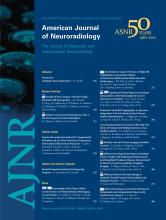Abstract
BACKGROUND AND PURPOSE: IR has recently demonstrated its capacity to reduce noise and permit dose reduction in abdominal and thoracic CT applications. The purpose of our study was to assess the potential benefit of IR in head CT by comparing objective and subjective image quality with standard FBP at various dose levels.
MATERIALS AND METHODS: Ninety consecutive patients were randomly assigned to undergo nonenhanced and contrast-enhanced head CT at a standard dose (320 mAs; CTDI, 60.1) or 15% (275 mAs; CTDI, 51.8) and 30% (225 mAs; CTDI, 42.3) dose reduction. All acquisitions were reconstructed with IR in image space, and FBP and images were assessed in terms of quantitative and qualitative IQ.
RESULTS: Compared with FBP, IR resulted in lower image noise (P ≤ .02), higher CNR (P ≤ .03), and improved subjective image quality (P ≤ .002) at all dose levels. While degradation of objective and subjective IQ at 15% dose reduction was fully compensated by IR (CNR, 1.98 ± 0.4 at 320 mAs with FBP versus 2.05 ± 0.4 at 275 mAs with IR; IQ, 1.8 versus 1.7), IQ was considerably poorer at 70% standard dose despite using the iterative approach (CNR, 1.98 ± 0.3 at 320 mAs with FBP versus 1.85 ± 0.4 at 225 mAs with IR, P = .18; IQ, 1.8 versus 2.2, P = .03). Linear regression analysis of CNR against tube current suggests that standard CNR may be obtained until approximately 20.4% dose reduction when IR is used.
CONCLUSIONS: Compared with conventional FBP, IR of head CT is associated with significant improvement of objective and subjective IQ and may allow dose reductions in the range of 20% without compromising standard image quality.
ABBREVIATIONS:
- CNR
- contrast-to-noise ratio
- CTDI
- CT dose index
- CTDIvol
- volume CT dose index
- DLP
- dose-length product
- FBP
- filtered back-projection
- GM
- gray matter
- IQ
- image quality
- IR
- iterative reconstruction
- IRIS
- iterative reconstruction in image space
- MDCT
- multidetector row CT
- © 2012 by American Journal of Neuroradiology












